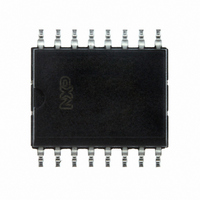SAA6581T/V1,512 NXP Semiconductors, SAA6581T/V1,512 Datasheet - Page 12

SAA6581T/V1,512
Manufacturer Part Number
SAA6581T/V1,512
Description
IC DEMODULATOR RDS/RBDS 16SOIC
Manufacturer
NXP Semiconductors
Datasheet
1.SAA6581TV1H518.pdf
(15 pages)
Specifications of SAA6581T/V1,512
Function
Demodulator, Filter
Lo Frequency
4.332MHz, 8.664MHz
Gain
20dB
Current - Supply
6mA
Voltage - Supply
4 V ~ 5.5 V
Package / Case
16-SOIC (0.300", 7.50mm Width)
Lead Free Status / RoHS Status
Lead free / RoHS Compliant
Noise Figure
-
P1db
-
Rf Frequency
-
Other names
935268605512
SAA6581TD
SAA6581TD
SAA6581TD
SAA6581TD
Philips Semiconductors
SOLDERING
Introduction
This text gives a very brief insight to a complex technology.
A more in-depth account of soldering ICs can be found in
our “Data Handbook IC26; Integrated Circuit Packages”
(document order number 9398 652 90011).
There is no soldering method that is ideal for all IC
packages. Wave soldering is often preferred when
through-hole and surface mount components are mixed on
one printed-circuit board. Wave soldering can still be used
for certain surface mount ICs, but it is not suitable for fine
pitch SMDs. In these situations reflow soldering is
recommended. Driven by legislation and environmental
forces the worldwide use of lead-free solder pastes is
increasing.
Through-hole mount packages
S
Typical dwell time of the leads in the wave ranges from
3 to 4 seconds at 250 C or 265 C, depending on solder
material applied, SnPb or Pb-free respectively.
The total contact time of successive solder waves must not
exceed 5 seconds.
The device may be mounted up to the seating plane, but
the temperature of the plastic body must not exceed the
specified maximum storage temperature (T
printed-circuit board has been pre-heated, forced cooling
may be necessary immediately after soldering to keep the
temperature within the permissible limit.
M
Apply the soldering iron (24 V or less) to the lead(s) of the
package, either below the seating plane or not more than
2 mm above it. If the temperature of the soldering iron bit
is less than 300 C it may remain in contact for up to
10 seconds. If the bit temperature is between
300 and 400 C, contact may be up to 5 seconds.
Surface mount packages
R
Reflow soldering requires solder paste (a suspension of
fine solder particles, flux and binding agent) to be applied
to the printed-circuit board by screen printing, stencilling or
pressure-syringe dispensing before package placement.
Several methods exist for reflowing; for example,
convection or convection/infrared heating in a conveyor
type oven. Throughput times (preheating, soldering and
2003 Oct 10
OLDERING BY DIPPING OR BY SOLDER WAVE
EFLOW SOLDERING
ANUAL SOLDERING
RDS/RBDS demodulator
stg(max)
). If the
12
cooling) vary between 100 and 200 seconds depending
on heating method.
Typical reflow peak temperatures range from
215 to 270 C depending on solder paste material. The
top-surface temperature of the packages should
preferably be kept:
Moisture sensitivity precautions, as indicated on packing,
must be respected at all times.
W
Conventional single wave soldering is not recommended
for surface mount devices (SMDs) or printed-circuit boards
with a high component density, as solder bridging and
non-wetting can present major problems.
To overcome these problems the double-wave soldering
method was specifically developed.
If wave soldering is used the following conditions must be
observed for optimal results:
During placement and before soldering, the package must
be fixed with a droplet of adhesive. The adhesive can be
applied by screen printing, pin transfer or syringe
AVE SOLDERING
below 220 C (SnPb process) or below 245 C (Pb-free
process)
– for all the BGA and SSOP-T packages
– for packages with a thickness
– for packages with a thickness < 2.5 mm and a
below 235 C (SnPb process) or below 260 C (Pb-free
process) for packages with a thickness < 2.5 mm and a
volume < 350 mm
Use a double-wave soldering method comprising a
turbulent wave with high upward pressure followed by a
smooth laminar wave.
For packages with leads on two sides and a pitch (e):
– larger than or equal to 1.27 mm, the footprint
– smaller than 1.27 mm, the footprint longitudinal axis
The footprint must incorporate solder thieves at the
downstream end.
For packages with leads on four sides, the footprint must
be placed at a 45 angle to the transport direction of the
printed-circuit board. The footprint must incorporate
solder thieves downstream and at the side corners.
volume
longitudinal axis is preferred to be parallel to the
transport direction of the printed-circuit board;
must be parallel to the transport direction of the
printed-circuit board.
350 mm
3
so called small/thin packages.
3
so called thick/large packages.
Product specification
2.5 mm
SAA6581









